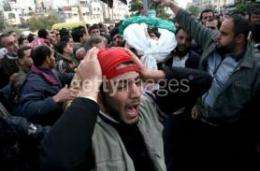UA study analyzes Israeli/Palestinian conflict news photos

Journalism faculty member Shahira Fahmy analyzed photos with differing points of view over the Gaza War.
Since 1948 and the establishment of the state of Israel, media coverage of the Arab/Israeli conflict has been a matter of extreme sensitivity and attention, not just for those who have been directly involved with it, but also to international news media and media academics around the globe.
In a study published in the recent issue of The American Behavioral Scientist, Shahira Fahmy, an associate professor in the University of Arizona School of Journalism, examined the photographic coverage of the Gaza War (2008-09) and the extent to which images of the conflict were portrayed as war vs. peace journalism in the three leading Western newswires (AP, Reuters, and Getty/AFP).
A peace journalism image is one that highlights peace initiatives and tones down differences by promoting conflict resolution. A war journalism image is one that highlights differences between opposing parties, urging violence as means to a resolution.
Based on this classification of images, Fahmy and Rico Neumann, an master's graduate from the UA department of communication, analyzed photographs to examine how the visual coverage of a Middle Eastern conflict is represented. Specifically, the researchers examined the extent to which newswire photos of the Gaza War varied in terms of war vs. peace journalism.
In analyzing the coverage, they found that nearly one in three children/adolescents in the images were depicted as wounded or dead – almost exclusively in the images in Gaza. As commonly known, the Gaza War quickly became the subject of controversy because of its high death toll among children in the Gaza Strip. On the Israeli side, only a few visuals exposed injured or dead adults, and no children lost their lives.
"Overall we found that the pool of photos including children outnumbered the pool of images featuring adults. We also found that negative emotions dominated these images and perhaps resulted in further demoralization of Palestinian citizens. In contrast, signs of hope and optimism were more common for images of Israelis," Fahmy said.
The researchers also found that the three leading Western newswire services combined (AP, Reuters, and Getty/AFP) provided more war journalism images than peace journalism images. Examples included more images of dead and wounded civilians and damaged infrastructure. In addition, their findings suggested all three newswire services provided a variety of visuals to communicate a comprehensive coverage of the conflict.
As Fahmy explained, "This variety of visuals that we observed put great emphasis on the role of editors in providing a better understanding of wars and conflicts to their readers. In other words, the selection to run specific images from the pool of available photographs covering the conflict was important in how the audiences visually experienced the conflict in Gaza."
Fahmy is a leading scholar in examining how journalists portray war and terrorism, particularly through visuals. She teaches research methods, media and terrorism and other courses in the UA School of Journalism.
Provided by University of Arizona
















